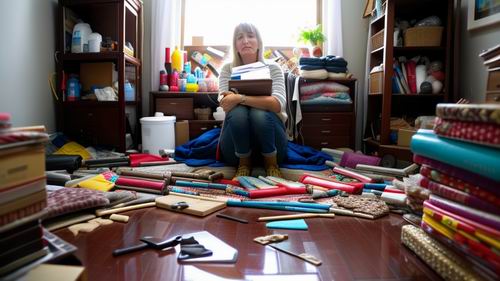- Main Principles of Humanistic Psychology : Understanding Humans as Complete Individuals
- Your Complete Roadmap To Recovering From Ghosting
- 10 Telltale Signs You are in a Cookie Jarring Relationship
- How to Shape a Positive and Confident Personality in Your Pet Bird
- How to Choose a Pet Bird That Complements Your Lifestyle and Personality
What is Hoarding Disorder?

Hoarding Disorder, a condition that affects countless individuals across the globe, is often misunderstood and mischaracterized. In this article, we will delve into the depths of this perplexing disorder, shedding light on its causes, symptoms, and potential treatments.
Unraveling the Mystery of Hoarding Disorder
Hoarding Disorder, a psychological condition, is marked by the excessive acquisition and retention of possessions, even those with little to no value. This compulsion can result in severe clutter, making living spaces nearly uninhabitable. Let's explore this condition further.
The Nature of Hoarding Behavior
Hoarding behavior goes beyond mere clutter; it involves an overwhelming urge to accumulate items, often due to a perceived need or emotional attachment. People with Hoarding Disorder find it extremely challenging to part with their possessions, leading to cramped and hazardous living conditions.
What Causes Hoarding Disorder?
While the exact cause of Hoarding Disorder remains elusive, it is believed to be influenced by a combination of genetic, environmental, and psychological factors. Trauma, for instance, can trigger hoarding tendencies as a coping mechanism.
Identifying the Symptoms
Recognizing Hoarding Disorder is crucial for early intervention. Common symptoms include:
- Excessive Clutter: A living space filled with items that are disorganized and chaotic.
- Difficulty Discarding: Extreme discomfort when attempting to dispose of possessions, even those with no practical value.
- Emotional Attachments: Hoarders often form deep emotional connections to their belongings.
- Social Isolation: Hoarding can lead to social withdrawal, as individuals become ashamed of their living conditions.
- Decline in Functionality: Daily functioning becomes compromised as clutter takes over living spaces.
Consequences of Hoarding Disorder
Hoarding Disorder can have severe consequences, not only for the individuals affected but also for their loved ones. It can lead to:
- Physical Health Issues: Clutter can pose fire hazards, create breeding grounds for pests, and increase the risk of falls.
- Mental Health Struggles: Hoarders often experience anxiety, depression, and a diminished quality of life.
- Relationship Strain: Loved ones may find it challenging to understand or tolerate the hoarding behavior, causing rifts in relationships.
Seeking Help and Treatment
Therapy and Counseling
For those grappling with Hoarding Disorder, therapy and counseling are essential components of treatment. Cognitive-Behavioral Therapy (CBT) has shown promise in helping individuals address the root causes of their hoarding tendencies and develop healthier habits.
Medication
In some cases, medication may be prescribed to manage the symptoms associated with Hoarding Disorder, such as anxiety and depression.
Support Groups
Joining support groups can provide individuals with Hoarding Disorder a safe space to share their experiences, gain insights, and receive encouragement from others facing similar challenges.
FAQs
Q1: What is Hoarding Disorder? A1: Hoarding Disorder is a mental health condition characterized by the excessive accumulation of possessions, an inability to discard items, and the resulting clutter, often to the point where living spaces become unusable.
Q2: Is Hoarding Disorder the same as being messy or disorganized? A2: No, Hoarding Disorder is distinct from simply being messy or disorganized. It involves an intense psychological compulsion to acquire and retain possessions, leading to extreme clutter and difficulty parting with items, even those with no practical value.
Q3: What causes Hoarding Disorder? A3: The exact cause of Hoarding Disorder is not fully understood, but it is believed to result from a combination of genetic, environmental, and psychological factors. Trauma, for example, can trigger hoarding tendencies as a coping mechanism.
Q4: How can I recognize if someone I know has Hoarding Disorder? A4: Look for signs such as an excessively cluttered living space, difficulty discarding items, emotional attachments to possessions, social withdrawal, and a decline in daily functionality. These may indicate Hoarding Disorder, and professional help should be sought.
Q5: Can Hoarding Disorder be treated? A5: Yes, Hoarding Disorder can be treated. Therapy, particularly Cognitive-Behavioral Therapy (CBT), is often used to address the root causes of hoarding behavior and develop healthier habits. Medication and support groups may also be part of the treatment plan.
Q6: What are the consequences of Hoarding Disorder? A6: Hoarding Disorder can lead to physical health issues (such as fire hazards and pest infestations), mental health struggles (including anxiety and depression), and strain on relationships due to the living conditions and difficulties in understanding the behavior.
Q7: Can I help someone with Hoarding Disorder? A7: Yes, supporting someone with Hoarding Disorder is crucial. Encourage them to seek professional help, be patient and empathetic, and offer assistance with decluttering if they are willing. Avoid judgment and criticism, as these can exacerbate the condition.
Q8: Is there hope for individuals with Hoarding Disorder to improve their living conditions and quality of life? A8: Absolutely. With the right treatment, support, and dedication, individuals with Hoarding Disorder can make significant improvements in their living conditions and overall well-being. It's important to seek help early to increase the chances of a positive outcome.
- 7 Ways to Grow a Growth Mindset
- Toxic Relationship : Signs, Impacts & How to Fix It
- How to Establish Healthy Boundaries in Relationships
- Tips for Creating a Plan to Achieve Your Goals
- Dealing With Passive Aggression in Relationships
- Coping With Imposter Syndrome
- The Benefits of Reprogramming Your Mind with Timeline Therapy
